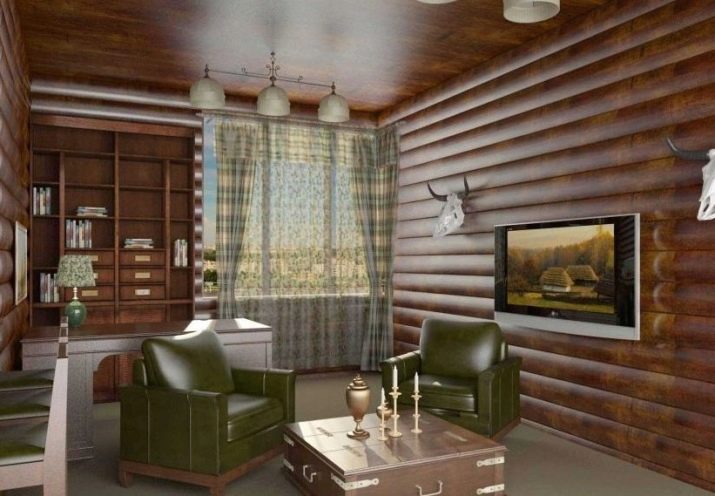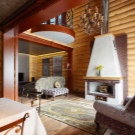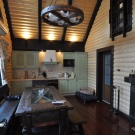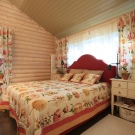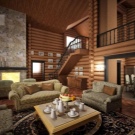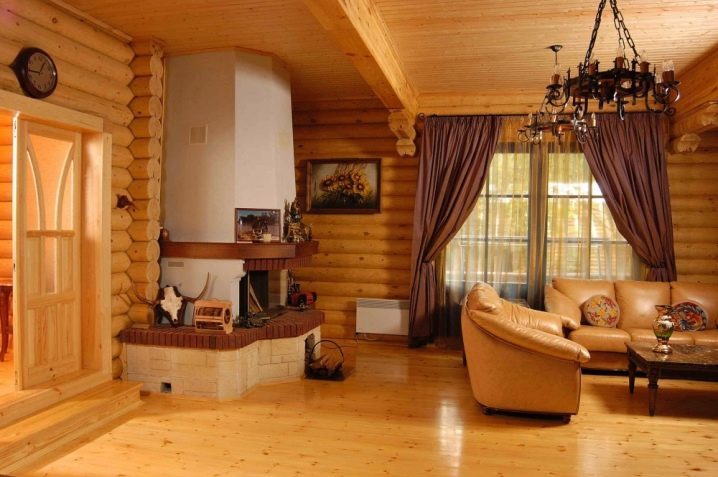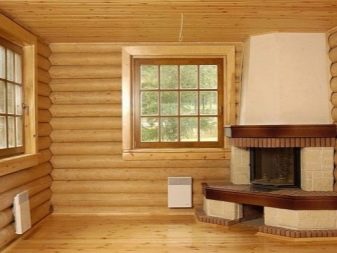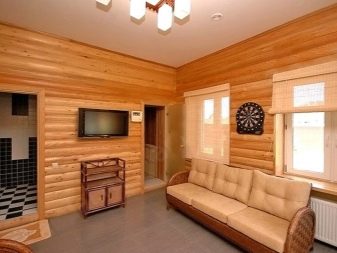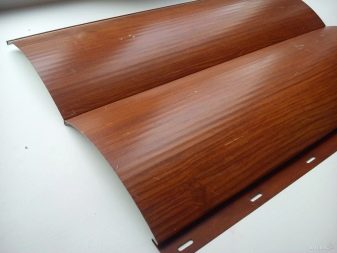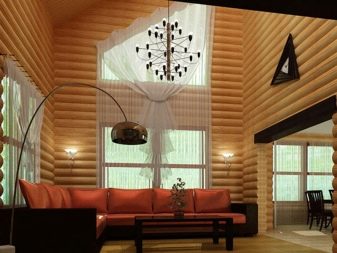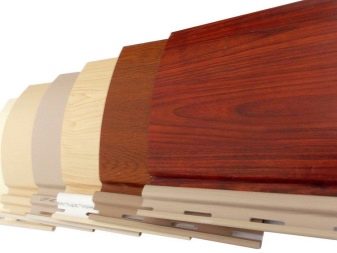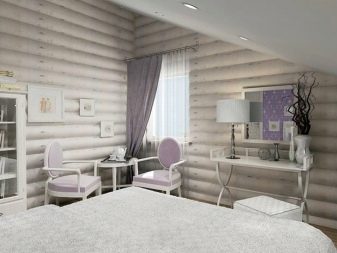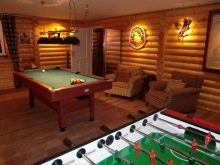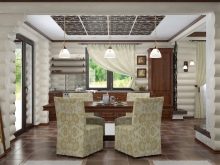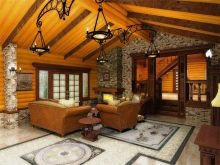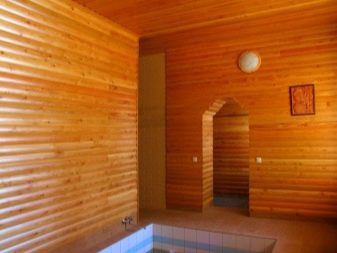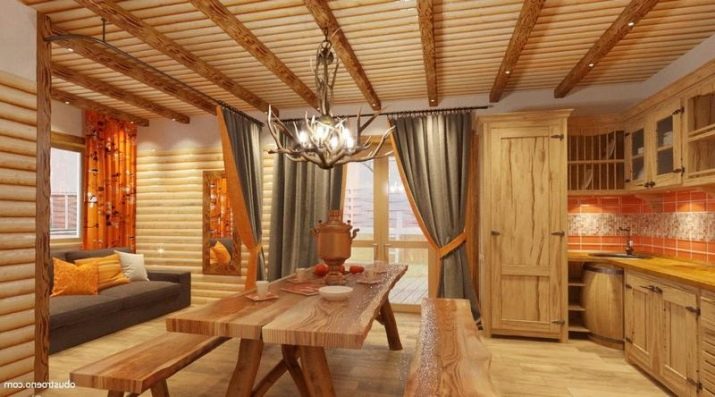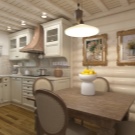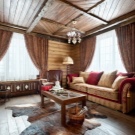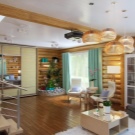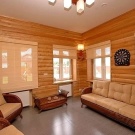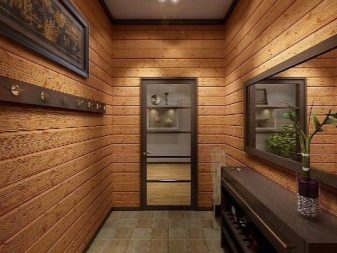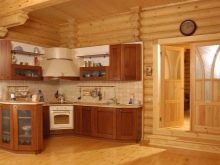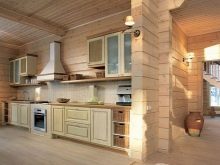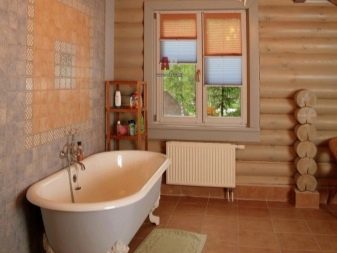Block house for interior decoration: room design ideas
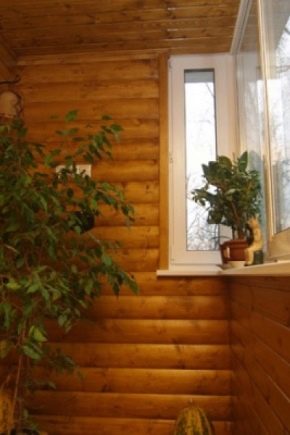
Modern interior decoration provides not only the creation of a beautiful interior, but also the use of high-quality natural materials. Therefore, recently the owners of houses and apartments as a decorative cladding choose a block house. This material is characterized by many positive qualities and is able to fill the space of rooms with a special atmosphere of home warmth and comfort. In addition, the block-house design indicates a good taste of homeowners, their ability to appreciate the natural beauty. The finishing material is easy to install, and the huge variety of its textures and colors opens up enormous opportunities for designers to implement creative ideas.
Special features
The block house is a unique building product, which is a type of wall paneling. Unlike the usual board, it is able to imitate a rounded log, thanks to this property it is widely used in decorative decoration. The process of making the material takes place according to special technologies using not only softwood, but also aspen, birch and linden.
The outer side of the block-house is convex and resembles a natural log in appearance, and the rear is flat. Installation of boards is carried out using puzzles. The result is a quality trim without gaps and gaps. Depending on the type of wood that is used in the production of a block house, its inherent characteristics may vary. There are class A and B boards, the main difference between which is the presence or absence of knots and other defects. Most often, the block house is chosen for decorative lining inside the premises, but before its installation it is worth considering the thickness of the boards, since it can “eat” the useful area of the room.
Usually, a block house is produced from 2 to 6 m in length. As for the thickness of the material, it varies from 20 to 36 mm, and the width can reach 190 mm.
Kinds
Today the block house is considered the most popular finishing material, which has high performance characteristics and allows you to create a strong and durable surface plating. According to the design of the design, boards are distinguished with imitation of not only a rounded log, but also a polished bar. In addition, a block house is of several types.
- Wooden. It is a classic version of the material, which is produced from various hardwood and softwood. As a rule, in the construction market such wooden boards can be found with a thickness of 2 to 4 cm. Therefore, for the interior lining of the room, in addition to decorative panels, it is also necessary to purchase insulation in addition. A wooden block house is expensive, but it has a high sound insulation and is a clean ecological product. It is recommended to mount the panels on a pre-assembled construction, which is prepared from the sheathing, sheathed with bars. The distance between the bars should not exceed 60 cm.
To obtain the maximum connection of the plates, they need to be fixed from bottom to top using the spike-puzzle system.In addition, to extend the life of such a finish, wooden boards should be treated with special antiseptics or stain.
- Metal. This type of material is resistant to high humidity and temperature extremes, does not need processing, is practical and reliable in operation. A metal block house can last up to 60 years. The panels are inexpensive and their, compared to wooden boards, is much easier to install. The fastening of the metal block house is also carried out on the batten, observing the step between the bars from 35 to 40 cm. Installation work can be performed in rooms with any temperature. In order to give an aesthetic appearance to the casing, additional elements are additionally used.
- Vinyl. Usually it is used only for interior decoration of rooms. Such a block house perfectly imitates a log, so with the help of it you can create an unusual interior. The material is produced in rich colors, does not need processing, is inexpensive and quickly installed. The only disadvantage of vinyl panels is their instability to temperature differences, as a result of which they can lose their strength and tarnish.The installation work with the vinyl block house is in many ways reminiscent of the installation of metal panels, but when installing it you must always leave a small gap of 2 mm between the boards. This should be done in order to avoid the formation of cracks on the surface of the material, since it can expand under external influence.
Each of the above types of panels requires not only a special installation technology, but also differs in its size and modification. Therefore, before choosing a particular type of material, you should first determine the design of the finish and take into account the peculiarities of the room where the decoration is planned.
Advantages and disadvantages
Like any other building product, a block house has its positive and negative characteristics.
The widespread use of this product in the interior decoration is due to its advantages.
- Environmental friendliness. Panels are made exclusively from natural raw materials. To do this, select high-quality wood, which is pre-processed and dried. In addition, a block house made of coniferous wood creates a good microclimate in the rooms.As for the boards of deciduous trees, they have high hardness and moisture resistance.
- Strength. Material can withstand a variety of environments. It is resistant to ultraviolet rays and does not lose its original appearance and quality over time.
- Aesthetics. The beautiful appearance of the boards allows them to be used for various decoration of rooms, further emphasizing the beauty of the interior. The material is produced in a variety of colors, so it fits perfectly into any room design.
- Lightweight and easy to install. Installation works are carried out quickly and do not require special tools, so they are quite realistic to do it yourself, without the help of specialists. In addition, the low weight of the panels does not require additional strengthening of the surfaces and the foundation of the house.
- Thermal insulation. The tree retains heat well.
As for the cons of the block house, then they can be attributed to them.
- Insufficient vapor permeability. The surface trimmed with this material “does not breathe”, therefore condensate may accumulate on it. Most often, a similar problem is observed in rooms where there is no constant temperature regime.To avoid this, it is enough to install a good ventilation system or to crate the walls with a pitch between the bars of 50 mm.
- Flammability Since it is usual to use natural wood for the production of a block house, you should worry about its protection from fire and treat it with a refractory solution.
Despite the presence of flaws, the finishing material is very popular among craftsmen and designers and has received positive feedback during operation.
How to choose?
Finishing work inside the house requires a lot of physical and financial costs, so that after they finish the result was pleased with high quality, you need to properly select the decorative material. The block house is a wall paneling, which has a convex shape and is intended for surface plating. For interior work, boards are used most often, not exceeding a length of 6 meters. In addition, when buying it is important to pay attention to the thickness of the material - if it is large, then the room after facing will decrease in area. The block-house of small thickness, on the contrary, takes up minimal space and successfully creates an atmosphere of coziness in the room.
The choice of panels also depends on the size of the room. For spacious rooms it is best to give preference to wide boards, thus it will be possible to achieve a better visual effect. In addition, a huge role when buying is played by a variety of wood. For the interior decoration of saunas and baths a block house made of alder, oak or linden is well suited. Living quarters are recommended to decorate with coniferous woods, they have a high resin content and provide the room with excellent waterproofing.
Room Design Ideas
Today, there are many ideas for the use of a block-house in the interior. Often this material is used in combination with bright paint or decorative plaster and wallpaper. Facing with natural stone and paneling will make a quality repair, which does not have to think for many years.
Particularly beautiful wood panels, placed on one of the walls in the bedroom. Thus, the sleeping area gets an interesting design, in it at the same time combines style and use. The tree fills the room with a pleasant aroma and creates an excellent atmosphere for relaxation. The corner lined with a block house looks unusual in the interior of the bedroom.In order not to disturb the unity of the image, it is recommended to decorate the boards and the ceiling. An interesting decor can be obtained by decorating one wall of the bedroom with a block house, and the other with clapboard.
In the event that you need to create a Provence style, then in the apartment it is best to use panels from natural wood for interior design, preferring light shades. In this case, the place of installation for them can serve not only the wall, but also the ceilings or furniture. Thanks to the play of colors and the use of boards of different textures in the rooms, it is possible to create an environment that will resemble a merchant or noble house.
The living room is considered the face of the owners, and therefore its design must be appropriate. To fill this room with chic and beauty, it is enough to sheathe the walls and ceiling with precious wood species. It is advisable to choose panels with imitation of a natural pattern of an array in the form of knots. At the same time, one wall with wood paneling looks good, while others are decorated with decorative plaster. This idea allows you to avoid monotony in the interior and fill the space with natural motifs.
A special place in the interior and takes the design of the corridor or hallway.For these rooms, it is possible to combine a block house with clapboard in the wall covering. Get an interesting transition in lines and colors. If the corridor and the hallway are small, then it is necessary to choose light shades of the panels. For this fit both brown and gray. In that case, if the area of these premises is large, then they are recommended to issue in the style of country and try to use the maximum number of colors in the casing. The combination of wooden panels with metal, stone and glass is also allowed in facing the walls of the corridor.
The block house found its place in the decor of the kitchen. For this room, you can choose boards of different colors. Especially elegant looks the kitchen in the style of Provence and Catri. The block house is installed on walls, ceilings, makes partitions of it and paints all surfaces with colors of warm shades. An original solution will be the treatment of semi-antique boards, after which they will acquire roughness and cracks. If the kitchen is decorated in the style of "Russian hut", then its interior can be diluted with artistic painting.
In the interior of the bathroom it is important to create a feeling of coziness and comfort,therefore, when covering the walls and ceiling, you need to choose the color of the block house correctly. Chocolate, white, gray, beige and tar-black wood will look good in the bathroom. In this decorative decoration should be supplemented with carvings and patterns. In addition, in the interior of the bathroom, you can use and cool or neutral shades. A block house in this room is best placed on one of the walls, and also decorated with a washbasin area. It is worth paying attention to the fact that the color of the furniture, the ceiling and the flooring should be in harmony with the wooden panels.
You can learn more about the block house for interior decoration in the following video.
